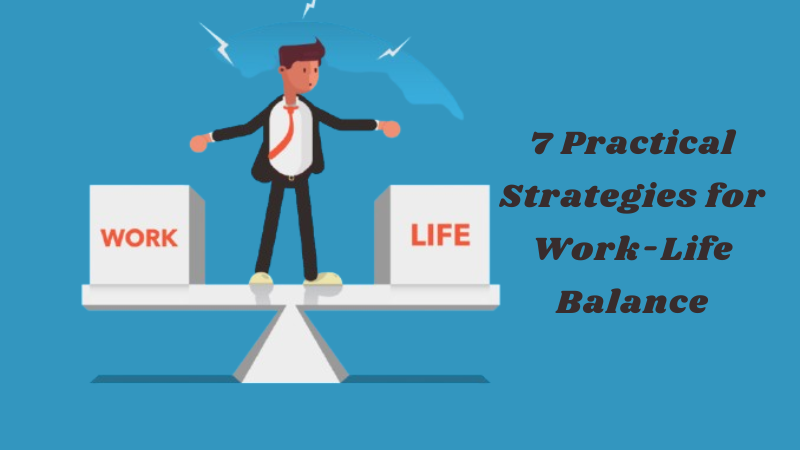Achieving a harmonious work-life balance is essential in today’s busy world. As demands at work intensify and personal responsibilities grow, finding equilibrium can feel impossible. This post explores practical strategies for enhancing your work-life balance while offering actionable tips, real-life examples, and introspective guidance. By implementing the ideas presented here, you can enjoy a healthier lifestyle, improve productivity, and reduce stress effectively.
What is Work-Life Balance?

The process of allocating sufficient time and energy to both professional and personal pursuits. It involves balancing your career with activities that bring joy and relaxation. The true essence of work-life balance is not about equal time allocation but achieving satisfaction in both domains.
The Evolution of Work-Life Concepts
Historically, society followed a strict 9-to-5 routine, where work was confined to specific hours. Today, changes in technology and remote working arrangements have blurred these boundaries, making the need for a robust work-life balance even more significant. According to a 2023 report by Buffer, 22% of remote workers struggle with unplugging after work, highlighting the challenges of maintaining boundaries.
The Importance of Maintaining Work-Life Balance
Achieving work-life balance is not just a luxury—it is a critical component of overall well-being. Here are some of the primary reasons why a sound work-life balance is essential to both personal and professional success:
1️⃣ Positive Impact on Mental and Physical Health
- Stress Reduction and Improved Mental Health: When work demands encroach excessively on personal time, chronic stress can be set in. Persistent stress is associated with anxiety, depression, and burnout, which can dramatically lower both productivity and quality of life. By establishing clear boundaries between work and leisure, you provide your mind with regular breaks. Research has shown that downtime and leisure activities are effective in reducing cortisol levels and rejuvenating neural pathways, leading to enhanced mental clarity and emotional resilience.
- Boosting Physical Health: A balanced life encourages regular physical activity, which is vital for preventing numerous health issues, including cardiovascular disease and obesity. Time spent on personal pursuits like exercising, walking, or engaging in recreational sports contributes to better heart health and improved energy levels. Integrating movement into your daily routine is a simple yet powerful way to strengthen your body and ensure long-term physical well-being.
2️⃣ Enhancing Professional Productivity: Numerous studies indicate that employees who maintain work-life balance have better problem-solving skills, exhibit more creative thinking, and are ultimately more productive.This balance directly influences job satisfaction and overall performance.
3️⃣ Encouraging Personal Growth: Achieving work-life balance allows you to invest time in hobbies, relationships, and self-development. Whether through learning new skills, engaging in creative hobbies, or pursuing educational opportunities, investing time in yourself leads to a richer, more fulfilling life.
4️⃣ Sustainable Success: Maintaining work-life balance isn’t just about immediate satisfaction—it’s a long-term strategy for success. By continuously integrating healthy work habits and personal care practices, you create a sustainable approach to managing stress, preventing burnout, and adapting to life’s inevitable changes.
7 Practical Strategies for Work-Life Balance
Achieving a harmonious work-life balance is essential for maintaining productivity and overall well-being. By implementing practical strategies such as effective time management, delegation, and self-care, you can create a sustainable routine that supports both your professional and personal life. Additionally, leveraging technology wisely can enhance efficiency while ensuring you have the time and energy to focus on what matters most.

1. Effective Time Management Techniques
Time management is the cornerstone of achieving work-life balance. Here we talk about the best techniques:
- Time Blocking and Prioritization: Allocate specific blocks of time throughout your day dedicated solely to work tasks, personal projects, and relaxation. Using a digital calendar or planner, schedule tasks based on priority to maximize productivity. This Structured approach minimizes distractions and ensures that you commit to both work and leisure activities.
- The Pomodoro Technique: Utilize techniques like the Pomodoro Technique, where you work in focused bursts (typically 25 minutes) followed by short breaks. This method helps maintain high levels of concentration and prevents burnout by ensuring regular periods of rest.
- Daily and Weekly Planning: Start each day with a clear list of tasks, and plan your week in advance. Outline key priorities, set realistic goals, and review your progress at the end of each day. This continuous planning cycle supports better organization and reduces the feeling of being overwhelmed.
2. Delegation and Outsourcing
Delegation is a powerful tool for reducing your workload.
- Identify Tasks That Can Be Delegated: Evaluate your workload and identify tasks that can be shared with colleagues or outsourced. Delegating routine or time-consuming tasks not only lightens your workload but also empowers others to contribute, creating a more collaborative environment.
- Leveraging Support Systems: Use available resources in both your professional and personal life. Whether it’s delegating a work project or hiring help for household responsibilities, letting others share the burden can free up valuable time for self-care and strategic thinking.
3. Harnessing the Power of Technology
Digital tools, such as calendars and productivity apps, can significantly streamline your daily routines. For instance, studies show that 87% of professionals believe productivity apps improve their work efficiency. However, be cautious of digital overload; Research indicates that 70% of people feel overwhelmed by constant notifications.
4. Incorporating Self-Care and Leisure into Your daily Routine
Studies show that 77% of people feel improved mental health when they engage in regular self-care activities. Simple habits—like taking short walks, meditating, or engaging in a favorite hobby—can reduce stress levels by up to 68%, according to research.
- Defining Self-Care: Self-care is not a luxury—it’s a necessity for achieving effective work-life balance. Dedicate time to activities that rejuvenate your spirit, whether it’s a hobby, exercise, or spending quality time with loved ones.
- Crafting a Personalized Self-Care Plan: Design a weekly plan that includes time for exercise, relaxation, and creative pursuits. Experiment with different activities until you discover what truly invigorates you. A tailored self-care routine is a practical way to enhance your overall work-life balance.
- Techniques to Manage Stress: Implement stress reduction methods such as mindfulness meditation, deep breathing exercises, or yoga. According to the American Psychological Association, mindfulness meditation can reduce stress by up to 39%, while deep breathing exercises have been shown to lower cortisol levels by 20%.
5. Defining Your Priorities
To build a fulfilling professional and personal life, start by identifying what truly matters to you. Studies show that 80% of people who clearly define their core values report higher life satisfaction. Define your core values and set clear goals, then rank them in order of importance. Research indicates that individuals who prioritize and align their goals with their values are 42% more likely to achieve them.
6. Creating Clear Boundaries and Routines
Establishing boundaries is key to protecting your time:
- Creating a Dedicated Workspace: If you work from home or in a hybrid environment, establish a designated area solely for work. This physical separation helps your brain distinguish between work time and personal time, reducing the temptation to spill work into your leisure hours.
- Setting Work Hours and Personal Time: Define your working hours and stick to them. Let your colleagues and family know when you are available and when you are not, ensuring that your personal time remains uninterrupted. Consistent routines make the transition between work and home smoother and more predictable.
- Scheduling Breaks and Downtime: Incorporate short, frequent breaks into your workday to prevent burnout. Whether it’s a five-minute pause every hour or a longer break in the middle of your day, these intervals can help you recharge and maintain peak performance without sacrificing personal well-being.
7. Mastering the Art of Saying “No”
Learning to say “no” is one of the toughest yet most vital aspects of achieving balance. Studies show that 82% of people who struggle to set boundaries experience higher levels of stress and burnout. Politely declining extra tasks or obligations can help prevent this and ensure you have ample time to nurture your personal life. Remember, a firm “no” today can pave the way for a positive “yes” in the future.
Tips for Embracing Change and Overcoming Challenges
Maintaining a healthy work-life balance is an ongoing journey that requires resilience, adaptability, and a willingness to grow. Life’s demands can often throw unexpected challenges to you way, but with the right mindset and strategies, you can navigate these obstacles effectively and create a more fulfilling life. Some of these tips:
- Recognizing Common Pitfalls: Obstacles such as unpredictable work demands and social pressures can derail your best plans. Identify these challenges early to develop resilience and adaptability. A flexible mindset can turn setbacks into learning opportunities that improve your work-life balance.
- Embracing Change and Adaptability: Understand that maintaining work-life balance is an evolving process. As your life circumstances change, so should your strategies too. Keep revisiting and refining your routines to ensure they remain effective and relevant to your current needs.
- Cultivating a Growth Mindset: Studies show that individuals with a growth mindset are 34% more likely to overcome challenges effectively. View setbacks as chances to improve rather than failures. With each adjustment, you are one step closer to mastering work-life balance and living a more fulfilling life.
Conclusion
Achieving work-life balance requires deliberate planning and a commitment to personal well-being. From defining your priorities to setting firm boundaries, every step you take contributes to a healthier, happier life. By integrating time management techniques, self-care practices, and flexibility, you can create a sustainable routine that supports both your professional and personal aspirations.
Now, it’s your turn. Reflect on your current routines and identify one or two strategies discussed in this post to implement immediately. Small, consistent changes can produce a significant impact on your work-life balance.







